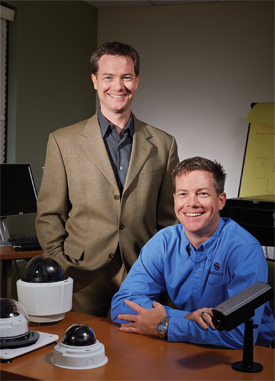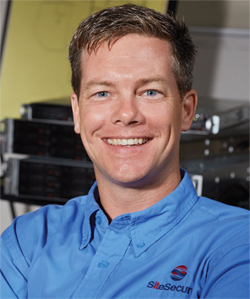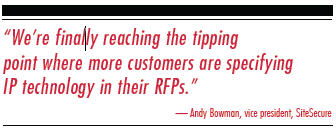Finally! Profits From IP Video
By Jay McCall, Business Solutions magazine
It’s been three years, but this VAR is finally seeing IP video surveillance sales take off and is projecting 33% revenue growth this year.

To truly understand SiteSecure’s current success in the physical security space, it’s important to first understand a little bit about its roots. Following Sept. 11, 2001, Wharton-Smith, a large, privately held construction company that works with commercial and environmental agencies such as water and waste-water treatment plants, recognized that physical security was going to become a major focus for its customers. Wharton- Smith spun off SiteSecure in February 2003 with four employees, none of whom had experience in the security industry. Two of the original members, Vice President Craig Bowman and former President (more about the former part later) Andy Bowman, were civil engineers employed by Wharton-Smith. The two brothers, plus a field engineer and a salesperson, had enough combined knowledge to be dangerous. “We started out focusing exclusively on water and waste-water companies, which were mandated by the federal government to perform vulnerability assessments,” recalls Craig Bowman. “Each utility company had to conduct its own study and develop a plan to fix any problems. It initially looked like this was going to be a lucrative opportunity, but the initiative quickly lost funding and wasn’t mandated, which put us in a tough position.”
SiteSecure was forced to quickly diversify, which it was able to do by following its parent company’s other key markets, such as aviation (airports) and education (K-12). One notable difference with the company’s early days in security compared with many of its competitors was the fact that it recognized the advantages of IP technology.
The Advantages Of Early IP Adoption
One of SiteSecure’s early physical-security implementations was with Seminole County, FL, government. The agency had an underground fiber-network infrastructure in place, but not enough to accommodate all the video bandwidth it needed for a surveillance camera project it was planning. “The existing infrastructure would accommodate only eight cameras over two strands of fiber,” recalls Craig Bowman. “Using IP, on the other hand, would enable 150 cameras to use the same network.” Considering it was 2003, IP cameras weren’t nearly as advanced as they are today, which required SiteSecure to create a work-around. “We initially used analog video cameras connected to encoders, which converted the analog signal to IP,” says Andy Bowman. “Additionally, DVRs were uncommon, so we had to convert the signal back to analog for the video recorders.” SiteSecure began researching for ways to simplify its surveillance solution and came across a company called Genetec, which had a software-based NVR (network video recorder) product. “Not only did this product enable us to avoid the expense of installing a second converter [called a multiplexor], it enabled us to allow our customers to use their own hardware.” Unlike traditional DVRs, which were stand-alone boxes that had to be shipped to the manufacturer if they stopped working, the NVR software ran on the customers’ servers and could be serviced by their internal IT department or a networking VAR if there were any problems. This move resulted in another advantage that SiteSecure would learn about over the next few years — improved reliability. “Many of the traditional DVRs that our competitors were selling were placed in closets, closest to where the cable was mounted,” says Andy Bowman. “In this environment, DVRs would become clogged with dust, overheat, and fail. The only component we installed in wiring closets was the encoder, which doesn’t have any moving parts. Servers were always installed in designated areas with proper temperature and ventilation controls, which meant that our video surveillance solution had a much lower failure rate compared to what some of our competitors were installing.”
The Convergence Trend Presents A Temporary Hiccup
Within the first five years of SiteSecure’s inception, it set up its customers’ NVRs on separate networks from their primary IT networks. This gave the company a lot of room for error when installing software on its customers’ servers. “We didn’t need to be concerned with network security issues, and we didn’t need to worry about factors such as QoS [quality of service] and packet prioritization,” says Andy Bowman. Around 2008, however, things started to change as more and more companies realized the advantages of running voice, video, and data applications on the same network, a practice known as convergence. Andy and Craig recall the time when their lack of networking knowledge needed to be addressed. “The IT guys were starting to become much more involved with the video surveillance buying decision-making process,” recalls Craig. “After a couple of painful conversations, we admitted to one another that we can’t even speak the same language as these guys. We also realized that training an existing employee, which would have required taking a semester course at a community college and investing hundreds of hours into training and certifications, just wasn’t feasible.” In early 2009, SiteSecure hired a networking engineer who already had the IT knowledge and networking certifications to give SiteSecure the IT credibility it had been lacking.


A Long-Term IP Commitment Finally Pays Off
SiteSecure did not experience double-digit growth over the next three years between 2009 and 2012, but it did manage to remain profitable. “We saw a lot of competitors go out of business during this time, but our vertical market diversity and decision to open a second office in the Tampa, FL, area were key factors to our survival,” says Craig. “During this time we made the switch from selling analog video surveillance cameras to Axis Communications IP cameras, once we saw that IP camera video quality caught and actually surpassed analog cameras.” (See sidebar on page 6s for more info about Axis Communications.)
In 2012, SiteSecure made a big decision that played a key role in moving the company from survival mode to profitability. In a hiring move rarely seen, Andy Bowman hired Jim Fairbanks as his replacement as president of the company, and he took a subordinate role as vice president. “My brother Craig and I are engineers at heart who like to be involved in the day-to-day projects more than the other essential decisions that go along with running a business,” says Andy. “Jim’s entrepreneurial personality allowed us to make some key changes that were long overdue and helped us get back on the double-digit growth path once again.” (See the sidebar “2 Ways The Right Leader Can Help Your Profitability” below.)
SiteSecure is already seeing positive results from its commitment to IP technology and its leadership change. “We’re finally reaching the tipping point where more customers are specifying IP technology in their RFPs,” says Andy. “Even though there are video surveillance companies that have been around longer than our company, it’s rare to find another company with as much IP experience as we have, which is another differentiator. Equally important to our technology expertise is our focus on three core beliefs: 1. Take care of the customer, 2. Take care of your coworkers, and 3. If we follow steps 1 and 2, we will work out everything else.”

